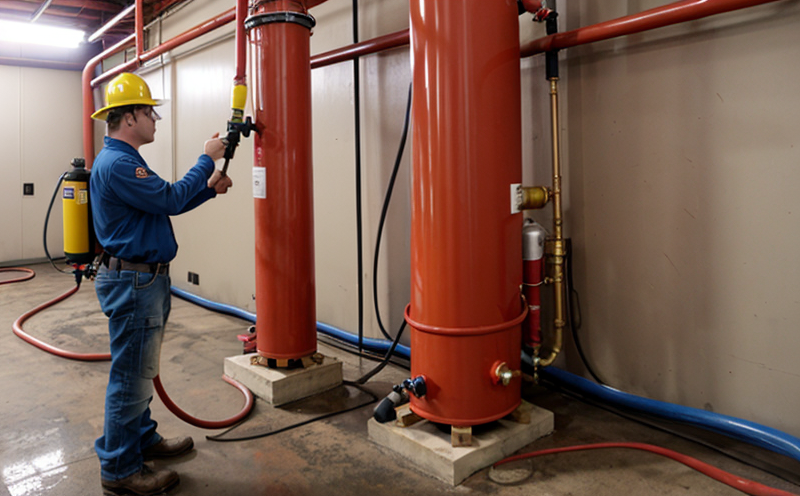Fire suppression system inspection
The fire suppression system is a critical component in any facility that aims to mitigate risks associated with potential fires. Properly functioning systems can prevent catastrophic damage and save lives, making regular inspections essential for compliance and safety.
A fire suppression system typically includes components such as nozzles, pipes, piping fittings, control valves, extinguishing agent containers, and activation devices. The integrity of these elements is crucial to the effectiveness of the system during an emergency. Our inspection services ensure that all parts are in optimal condition, meeting both local codes and international standards like ISO 14523 or NFPA 10.
The process begins with a thorough visual examination of each component, followed by detailed functional testing under simulated conditions. This includes checking for any signs of wear and tear, corrosion, leaks, and ensuring proper sealing and connections between parts. The inspection also covers the operation of electronic controls and interfaces to ensure they function correctly.
Once all components have been evaluated, our team conducts a series of tests designed to simulate real-world scenarios. These include pressure testing, leak detection, flow rate measurement, and performance under various activation conditions. For example, we may use ISO 17845-2:2019 for dry-pipe systems or NFPA 13 to test wet systems.
Compliance with local regulations is paramount, and our services include ensuring that all inspections meet the requirements set forth by authorities such as the National Fire Protection Association (NFPA) and Underwriters Laboratories (UL). Additionally, we adhere strictly to international standards like ISO 9658 for CO2 systems or EN 345:2017 for Halon alternatives.
Our team of experts uses advanced diagnostic tools and equipment to identify potential issues before they become critical. This proactive approach helps prevent failures during emergencies, thereby enhancing overall safety within the facility. By leveraging cutting-edge technology and years of experience in this field, we provide reliable and accurate inspections that meet the highest standards.
Regular inspections are not just about maintaining compliance but also about ensuring long-term reliability and efficiency of fire suppression systems. Our services help facilities maintain peace of mind knowing their critical safety measures are functioning properly at all times.
Customer Impact and Satisfaction
The impact of our fire suppression system inspection services extends beyond mere compliance; it significantly enhances the overall safety and operational efficiency of facilities. For quality managers, this means less downtime due to unexpected failures, which translates directly into cost savings. Compliance officers can rest assured that all necessary inspections are conducted according to stringent standards, reducing legal risks associated with non-compliance.
For R&D engineers, our services offer valuable insights into the performance of different system components under various conditions. This data can be used to improve designs and identify areas for innovation. Procurement teams benefit from knowing that their suppliers meet rigorous quality benchmarks, ensuring that only reliable products are chosen for future projects.
Satisfaction among customers is high due to our commitment to excellence in every aspect of the inspection process. We provide comprehensive reports detailing all findings along with recommendations for corrective actions where needed. Regular follow-ups ensure continuous improvement and adherence to best practices.
Our services go beyond just meeting regulatory requirements; they contribute positively towards achieving organizational goals related to safety, sustainability, and cost management. By investing in our inspection services, customers demonstrate their dedication to creating safer environments while fostering trust among stakeholders.
International Acceptance and Recognition
The global nature of business today means that facilities must adhere to international standards when it comes to fire suppression systems. Our inspection services are designed to meet these high expectations, ensuring that every component meets the stringent requirements set forth by recognized bodies such as ISO, NFPA, EN, and IEC.
For instance, compliance with ISO 14523 ensures that all aspects of a dry-pipe system are evaluated comprehensively. Similarly, NFPA 10 covers everything from portable fire extinguishers to pre-engineered systems. International equivalents like EN 345 for Halon alternatives and IEC 62874-2 for CO2 systems provide additional layers of assurance that each component is up-to-date with the latest technology.
Our expertise in these areas has earned us recognition from various institutions around the world, cementing our position as leaders in this field. This reputation translates into greater trust from clients who know they are receiving services from a trusted source.
Beyond mere compliance, we strive to push the boundaries of what is possible in fire protection technology. By staying abreast of global developments and trends, we ensure that our inspections reflect the very best practices available today. This forward-thinking approach not only enhances current safety measures but also sets the stage for future advancements.
Environmental and Sustainability Contributions
In addition to ensuring immediate safety, fire suppression systems play a crucial role in sustainable practices. By preventing fires from occurring or minimizing their impact when they do happen, these systems contribute positively towards environmental conservation efforts.
The choice of extinguishing agents used is critical here; some options are more environmentally friendly than others. For example, using CO2 instead of halons reduces ozone depletion potential while still being highly effective at suppressing fires. Our inspections ensure that facilities opt for the most sustainable solutions available without compromising on performance or safety.
Furthermore, by maintaining systems efficiently and effectively, we help minimize waste generation associated with frequent replacements due to failures. This leads to reduced resource consumption throughout a facility’s lifecycle. Additionally, improved energy efficiency through better system maintenance contributes towards lower carbon footprints.
The continuous evolution of fire protection technologies presents exciting opportunities for further integration into broader sustainability initiatives. As standards continue to rise and new materials become available, we remain at the forefront of these developments, ensuring that our services align perfectly with evolving needs both locally and internationally.





